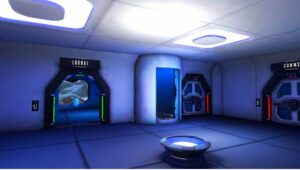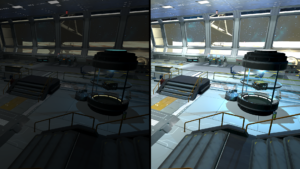What Does Neurodiversity Look Like? One Project’s Answer
By Teon Edwards
“What does neurodiversity look like to me?” I have too many answers… and maybe that’s the point, as there is no one way to capture the diversity of neurodiversity. But if I narrow my scope to the work of just one project, and I latch onto the words “look like”, here are my initial ideas.
To me, neurodiversity looks like the members of the co-design team for our project Broadening Participation in Informal STEM Learning for Autistic Learners and Others through Virtual Reality. Most members identify as neurodivergent, and all together, we are a wonderful, rich sample of neurodiversity.
To me, neurodiversity also looks like the choices we made related to visual — “look like” — aspects of the VR game this team designed together. It’s the game color palette, selected based both on team input and on research about the color preferences of neurodivergent learners. It’s the in-game brightness controls, situated throughout the game like dimmer light switches. Our research gave us solid defaults for the brightness preferences of both neurodivergent and neurotypical participants, but with enough range and enough outliers to advocate for giving individuals easy control. And it’s the lack of visual movement queues in the game, as many players, especially neurodivergent ones, find the mismatch of being stationary but seeing movement signals to be dizzying or even nauseating.
There’s definitely no one “look” to neurodiversity, but visual and other sensory elements are an important part of design by, with, and for neurodivergent learners—and indeed, for all learners.
Learn more about the project and game here.


“What does neurodiversity look like to me?” I have too many answers… and maybe that’s the point, as there is no one way to capture the diversity of neurodiversity. But if I narrow my scope to the work of just one project, and I latch onto the words “look like”, here are my initial ideas.
To me, neurodiversity looks like the members of the co-design team for our project Broadening Participation in Informal STEM Learning for Autistic Learners and Others through Virtual Reality. Most members identify as neurodivergent, and all together, we are a wonderful, rich sample of neurodiversity.
To me, neurodiversity also looks like the choices we made related to visual — “look like” — aspects of the VR game this team designed together. It’s the game color palette, selected based both on team input and on research about the color preferences of neurodivergent learners. It’s the in-game brightness controls, situated throughout the game like dimmer light switches. Our research gave us solid defaults for the brightness preferences of both neurodivergent and neurotypical participants, but with enough range and enough outliers to advocate for giving individuals easy control. And it’s the lack of visual movement queues in the game, as many players, especially neurodivergent ones, find the mismatch of being stationary but seeing movement signals to be dizzying or even nauseating.
There’s definitely no one “look” to neurodiversity, but visual and other sensory elements are an important part of design by, with, and for neurodivergent learners—and indeed, for all learners.
Learn more about the project and game here.



3/11/2025
AuthorTeon Edwards is the director and a co-founder of EdGE at TERC. Her current work focuses on the use of virtual reality and other technologies to design and develop inclusive STEM learning experiences, with a particular focus on neurodiversity and sensory, attention, and social differences.
SummaryThis blog post describes an answer to the question “What does neurodiversity look like?” It focuses on “look”, or visual, aspects of a project co-designing a virtual reality game.
Share This Page: